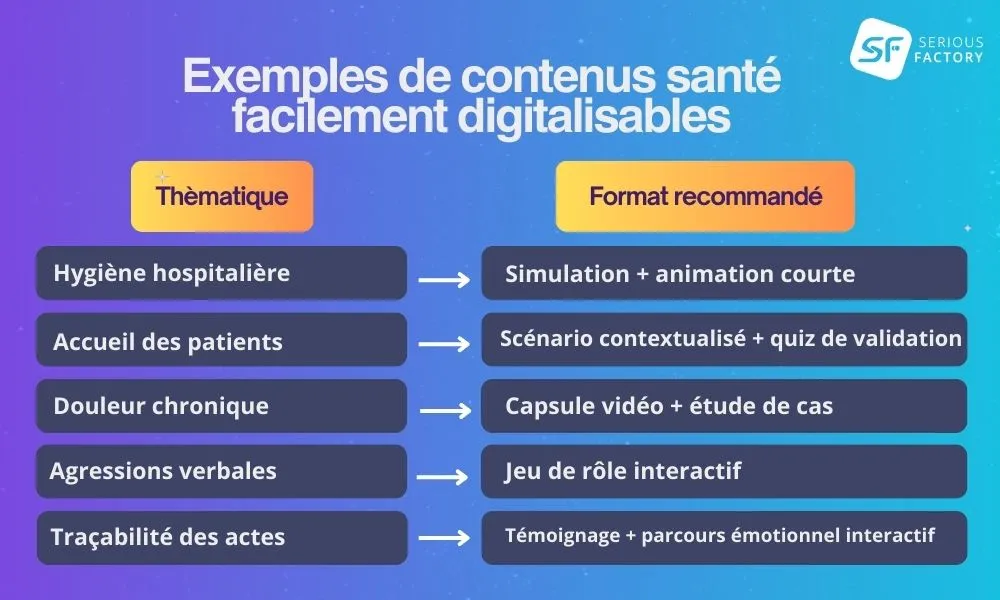In a hospital, EHPAD or medico-social center, training is never just a “plus”. It is central to the quality of care, patient safety and skills maintenance. But in a context where teams are under constant pressure, how can they be trained effectively without increasing their mental workload? How to digitize… without dehumanizing?
In 2025, the digitization of healthcare training is no longer just a matter of distributing a PowerPoint on hygiene or a generic e-learning course on pain. It has to adapt to the pace, constraints and specific needs of caregivers: those who work 3×8, who deal with the unexpected in real time, and who need to feel useful… even in training.
A sector in search of agility… and meaning
Healthcare establishments face a complex equation:
📉 Less time available, more turnover, more standards.
📈 More training needs: new practices, updated protocols, DPC, accreditations, HAS certifications…
According to a study conducted by the CNEH (2023), more than 6 out of 10 hospital establishments identify the lack of time for caregivers as the main obstacle to continuing training. And yet, obsolete or inappropriate training can have direct consequences: medication errors, poor posture, lack of coordination, etc. The challenge is to design teaching formats that are fast, reliable and useful on a daily basis. In a word: operational.
Why digitalize training in a healthcare establishment?
The aim of digitalization is not to “replace” existing systems, but to make them more fluid, accessible and traceable. If well thought-out, it becomes a powerful lever for enhancing skills, without disrupting the organization of care.
Concrete benefits:
Save time: short modules, accessible between two procedures or during an administrative slot.
Training without mobilizing a room: useful in the event of a health crisis or chronic understaffing.
Adapt to complex schedules: 24/7, on computer or tablet.
Ensure traceability: proof of follow-up for audits, quality standards or CPD.
Simulate sensitive situations: violence, emergencies, potential errors… without taking real risks.
What to Avoid at All Costs
Many initiatives fail because they don’t speak the language of caregivers. Here’s what’s causing problems in the field:
❌ Modules that are too long or too abstract: A PowerPoint repurposed as a clickable PDF is not training.
❌ Top-down pedagogy: Healthcare professionals are into action. They want to understand why they’re learning, and what it’s good for.
❌ Off-ground content: Talking about technical gestures without showing the context (room, equipment, patient) has no impact.
❌ Forgetting the human element: Pain management, relations with families, emotional intelligence… These are not skills that can be imparted through multiple-choice quizzes.
5 steps to effective digitalization in the healthcare sector
1. Identify a Real, On-the-Ground Need
Avoid “gadget” digitalization. Start with an actual operational challenge:
- Too many admission errors?
- Difficulties onboarding new staff?
- Isolation protocols poorly followed?
2. Define a Clear, Actionable Learning Objective
Focus on tangible, real-world outcomes:
- “Apply the X admission protocol”
- “Manage verbal aggression without escalation”
- “Identify key steps in the medication process”
3. Choose a Format that Fits the Content
Match the learning format to the type of skill:
- Scenario-based micro-modules for technical procedures
- Interactive simulations for soft skills and patient interaction
- Short videos or quizzes for regulatory refreshers
- Dynamic checklists for protocol application
4. Prototype Quickly, Test Early
Forget the five-year plan. A single, well-targeted module piloted in one unit is enough to validate real-world use.
5. Integrate Feedback from the Field
Healthcare teams are the true validators. They must be empowered to comment, adjust, and co-create the tools they use.

Which Tools Should You Use to Create This Content?
Not Every Training Department Has a Video Studio — And That’s Not a Problem
You don’t need high-end audiovisual equipment to get started.
Authoring tools like VTS Editor, developed by Serious Factory, allow training teams to create modules:
- Without advanced technical skills
- Using templates specifically designed for the healthcare sector
- While retaining full control over content, design, and updates
The most successful institutions are those that empower their in-house trainers rather than outsourcing all content production.
That’s what creates real, lasting impact on the ground.
Customer Case: Novartis
Context:
Regular onboarding of new field team members (medical sales representatives and hospital delegates), with high stakes in terms of compliance and rapid skills development.
Objective:
Speed up the onboarding journey while ensuring full mastery of key messages and regulatory best practices.
Deployed Solution:
- An interactive onboarding module featuring an immersive introduction to teams and products
- Quick-reference guides on compliance rules and traceability
- Scenario-based exercises for handling objections during medical visits
Results:
- 100% of new hires completed the program independently
- 35% time savings on in-person training sessions
- Improved message retention according to team managers
Train fast, train right… and train with a human touch
Digitalizing healthcare training is not about following a trend. It’s about meeting an urgent need for educational continuity despite structural pressures.
It’s also a way to safeguard quality of care by giving healthcare professionals the right reflexes at the right time.
And the good news? Transformation can start small. A single module to pilot, a test service, an easy-to-use tool.
The technology exists. The expertise is here. All that’s missing is a clear direction, aligned with real-world needs.









